Electrochemical Reduction Performance and Mechanism of 2,2′,4,4′-Tetrabromodiphenyl Ether (BDE-47) with Pd/Metal Foam Electrodes
Abstract
1. Introduction
2. Materials and Methods
2.1. Chemicals
2.2. Preparation of Metal Foam Electrodes
2.2.1. Pre-Treatment of Metal Foam Electrodes
2.2.2. Synthesis of Pd-Modified Metal Foam Electrodes
2.3. Degradation Procedures
2.4. Analytic Methods
2.5. Characterization of Pd/Metal Foam
3. Results and Discussion
3.1. Kinetics
3.2. Degradation Products and Mechanisms
3.3. Influencing Factors
3.3.1. Electrolytes
3.3.2. Current Intensity
3.3.3. PBDEs with Different Bromination Degrees
3.4. SEM Characterization
3.5. Electrode Cycling Performance
4. Conclusions
Supplementary Materials
Author Contributions
Funding
Data Availability Statement
Acknowledgments
Conflicts of Interest
References
- Abbasi, G.; Li, L.; Breivik, K. Global Historical Stocks and Emissions of PBDEs. Environ. Sci. Technol. 2019, 53, 6330–6340. [Google Scholar] [CrossRef] [PubMed]
- Anh, H.Q.; Nam, V.D.; Tri, T.M.; Ha, N.M.; Ngoc, N.T.; Mai, P.T.N.; Anh, D.H.; Minh, N.H.; Tuan, N.A.; Minh, T.B. Polybrominated Diphenyl Ethers in Plastic Products, Indoor Dust, Sediment and Fish from Informal e-Waste Recycling Sites in Vietnam: A Comprehensive Assessment of Contamination, Accumulation Pattern, Emissions, and Human Exposure. Environ. Geochem. Health 2017, 39, 935–954. [Google Scholar] [CrossRef] [PubMed]
- Wang, R.; Cheng, H.; Bian, Z. Global Occurrence and Environmental Behavior of Novel Brominated Flame Retardants in Soils: Current Knowledge and Future Perspectives. J. Hazard. Mater. 2024, 480, 136298. [Google Scholar] [CrossRef]
- Sharkey, M.; Harrad, S.; Abou-Elwafa Abdallah, M.; Drage, D.S.; Berresheim, H. Phasing-out of Legacy Brominated Flame Retardants: The UNEP Stockholm Convention and Other Legislative Action Worldwide. Environ. Int. 2020, 144, 106041. [Google Scholar] [CrossRef]
- Labunska, I.; Harrad, S.; Wang, M.; Santillo, D.; Johnston, P. Human Dietary Exposure to PBDEs Around E-Waste Recycling Sites in Eastern China. Environ. Sci. Technol. 2014, 48, 5555–5564. [Google Scholar] [CrossRef]
- Liang, J.; Wang, R.; Liu, H.; Xie, D.; Tao, X.; Zhou, J.; Yin, H.; Dang, Z.; Lu, G. Unintentional Formation of Mixed Chloro-Bromo Diphenyl Ethers (PBCDEs), Dibenzo-p-Dioxins and Dibenzofurans (PBCDD/Fs) from Pyrolysis of Polybrominated Diphenyl Ethers (PBDEs). Chemosphere 2022, 308, 136246. [Google Scholar] [CrossRef]
- Liang, J.; Lu, G.; Wang, R.; Tang, T.; Huang, K.; Jiang, F.; Yu, W.; Tao, X.; Yin, H.; Dang, Z. The Formation Pathways of Polybrominated Dibenzo-p-Dioxins and Dibenzofurans (PBDD/Fs) from Pyrolysis of Polybrominated Diphenyl Ethers (PBDEs): Effects of Bromination Arrangement and Level. J. Hazard. Mater. 2020, 399, 123004. [Google Scholar] [CrossRef] [PubMed]
- Li, T.-Y.; Zhou, J.-F.; Wu, C.-C.; Bao, L.-J.; Shi, L.; Zeng, E.Y. Characteristics of Polybrominated Diphenyl Ethers Released from Thermal Treatment and Open Burning of E-Waste. Environ. Sci. Technol. 2018, 52, 4650–4657. [Google Scholar] [CrossRef]
- Guo, J.; Zhang, R.; Xu, Z. PBDEs Emission from Waste Printed Wiring Boards during Thermal Process. Environ. Sci. Technol. 2015, 49, 2716–2723. [Google Scholar] [CrossRef]
- Gao, S.; Hong, J.; Yu, Z.; Wang, J.; Yang, G.; Sheng, G.; Fu, J. Polybrominated Diphenyl Ethers in Surface Soils from E-Waste Recycling Areas and Industrial Areas in South China: Concentration Levels, Congener Profile, and Inventory. Environ. Toxicol. Chem. 2011, 30, 2688–2696. [Google Scholar] [CrossRef]
- Li, W.-L.; Ma, W.-L.; Jia, H.-L.; Hong, W.-J.; Moon, H.-B.; Nakata, H.; Minh, N.H.; Sinha, R.K.; Chi, K.H.; Kannan, K.; et al. Polybrominated Diphenyl Ethers (PBDEs) in Surface Soils across Five Asian Countries: Levels, Spatial Distribution, and Source Contribution. Environ. Sci. Technol. 2016, 50, 12779–12788. [Google Scholar] [CrossRef] [PubMed]
- Liu, M.; Huang, B.; Bi, X.; Ren, Z.; Sheng, G.; Fu, J. Heavy Metals and Organic Compounds Contamination in Soil from an E-Waste Region in South China. Environ. Sci. Process. Impacts 2013, 15, 919. [Google Scholar] [CrossRef] [PubMed]
- Tang, X.; Zeng, B.; Hashmi, M.Z.; Long, D.; Yu, B.; Ullah, N.; Shen, C.; Chen, Y. PBDEs and PCDD/Fs in Surface Soil Taken from the Taizhou e-Waste Recycling Area, China. Chem. Ecol. 2014, 30, 245–251. [Google Scholar] [CrossRef]
- Zhang, S.; Xu, X.; Wu, Y.; Ge, J.; Li, W.; Huo, X. Polybrominated Diphenyl Ethers in Residential and Agricultural Soils from an Electronic Waste Polluted Region in South China: Distribution, Compositional Profile, and Sources. Chemosphere 2014, 102, 55–60. [Google Scholar] [CrossRef]
- Huang, Y.; Zhang, D.; Yang, Y.; Zeng, X.; Ran, Y. Distribution and Partitioning of Polybrominated Diphenyl Ethers in Sediments from the Pearl River Delta and Guiyu, South China. Environ. Pollut. 2018, 235, 104–112. [Google Scholar] [CrossRef]
- Alabi, O.A.; Bakare, A.A.; Xu, X.; Li, B.; Zhang, Y.; Huo, X. Comparative Evaluation of Environmental Contamination and DNA Damage Induced by Electronic-Waste in Nigeria and China. Sci. Total Environ. 2012, 423, 62–72. [Google Scholar] [CrossRef]
- Labunska, I.; Harrad, S.; Santillo, D.; Johnston, P.; Brigden, K. Levels and Distribution of Polybrominated Diphenyl Ethers in Soil, Sediment and Dust Samples Collected from Various Electronic Waste Recycling Sites within Guiyu Town, Southern China. Environ. Sci. Process. Impacts 2013, 15, 503. [Google Scholar] [CrossRef]
- Ling, S.; Zhou, S.; Tan, J.; Lu, C.; Fu, M.; Peng, C.; Zhang, W.; Hu, S.; Lin, K.; Zhou, B. Brominated Flame Retardants (BFRs) in Sediment from a Typical e-Waste Dismantling Region in Southern China: Occurrence, Spatial Distribution, Composition Profiles, and Ecological Risks. Sci. Total Environ. 2022, 824, 153813. [Google Scholar] [CrossRef]
- Yu, K.; Gu, C.; Boyd, S.A.; Liu, C.; Sun, C.; Teppen, B.J.; Li, H. Rapid and Extensive Debromination of Decabromodiphenyl Ether by Smectite Clay-Templated Subnanoscale Zero-Valent Iron. Environ. Sci. Technol. 2012, 46, 8969–8975. [Google Scholar] [CrossRef]
- Su, J.; Lu, N.; Zhao, J.; Yu, H.; Huang, H.; Dong, X.; Quan, X. Nano-Cubic Structured Titanium Nitride Particle Films as Cathodes for the Effective Electrocatalytic Debromination of BDE-47. J. Hazard. Mater. 2012, 231–232, 105–113. [Google Scholar] [CrossRef]
- Wang, R.; Tang, T.; Lu, G.; Huang, K.; Yin, H.; Lin, Z.; Wu, F.; Dang, Z. Rapid Debromination of Polybrominated Diphenyl Ethers (PBDEs) by Zero Valent Metal and Bimetals: Mechanisms and Pathways Assisted by Density Function Theory Calculation. Environ. Pollut. 2018, 240, 745–753. [Google Scholar] [CrossRef] [PubMed]
- Tang, T.; Lu, G.; Wang, R.; Chen, H.; Fang, Y.; Huang, K.; Zheng, J.; Zou, M.; Tao, X.; Yin, H.; et al. Debromination of Polybrominated Diphenyl Ethers (PBDEs) by Zero Valent Zinc: Mechanisms and Predicting Descriptors. J. Hazard. Mater. 2018, 352, 165–171. [Google Scholar] [CrossRef] [PubMed]
- Wang, R.; Lu, G.; Lin, H.; Huang, K.; Tang, T.; Xue, X.; Yang, X.; Yin, H.; Dang, Z. Relative Roles of H-Atom Transfer and Electron Transfer in the Debromination of Polybrominated Diphenyl Ethers by Palladized Nanoscale Zerovalent Iron. Environ. Pollut. 2017, 222, 331–337. [Google Scholar] [CrossRef]
- Lei, M.; Wang, N.; Zhu, L.; Tang, H. Peculiar and Rapid Photocatalytic Degradation of Tetrabromodiphenyl Ethers over Ag/TiO2 Induced by Interaction between Silver Nanoparticles and Bromine Atoms in the Target. Chemosphere 2016, 150, 536–544. [Google Scholar] [CrossRef] [PubMed]
- Shi, J.; Qu, R.; Feng, M.; Wang, X.; Wang, L.; Yang, S.; Wang, Z. Oxidative Degradation of Decabromodiphenyl Ether (BDE 209) by Potassium Permanganate: Reaction Pathways, Kinetics, and Mechanisms Assisted by Density Functional Theory Calculations. Environ. Sci. Technol. 2015, 49, 4209–4217. [Google Scholar] [CrossRef]
- Liang, J.; Liu, H.; Zou, M.; Tao, X.; Zhou, J.; Dang, Z.; Lu, G. Degradation Efficiency and Mechanism of 2,2′,4,4′-Tetrabromodiphenyl Ether (BDE-47) by Thermally Activated Persulfate System. Chemosphere 2023, 325, 138396. [Google Scholar] [CrossRef] [PubMed]
- Luo, S.; Yang, S.; Sun, C.; Gu, J.-D. Improved Debromination of Polybrominated Diphenyl Ethers by Bimetallic Iron–Silver Nanoparticles Coupled with Microwave Energy. Sci. Total Environ. 2012, 429, 300–308. [Google Scholar] [CrossRef]
- Li, L.; Chang, W.; Wang, Y.; Ji, H.; Chen, C.; Ma, W.; Zhao, J. Rapid, Photocatalytic, and Deep Debromination of Polybrominated Diphenyl Ethers on Pd–TiO2: Intermediates and Pathways. Chem. Eur. J. 2014, 20, 11163–11170. [Google Scholar] [CrossRef]
- Du, X.; Li, H.; Liang, J.; Wang, R.; Huang, K.; Hayat, W.; Cai, L.; Tao, X.; Dang, Z.; Lu, G. Hydrogen-Donor-Controlled Polybrominated Dibenzofuran (PBDF) Formation from Polybrominated Diphenyl Ether (PBDE) Photolysis in Solutions: Competition Mechanisms of Radical-Based Cyclization and Hydrogen Abstraction Reactions. Environ. Sci. Technol. 2023, 57, 7777–7788. [Google Scholar] [CrossRef]
- Konstantinov, A.; Bejan, D.; Bunce, N.J.; Chittim, B.; McCrindle, R.; Potter, D.; Tashiro, C. Electrolytic Debromination of PBDEs in DE-83TM Technical Decabromodiphenyl Ether. Chemosphere 2008, 72, 1159–1162. [Google Scholar] [CrossRef]
- Peverly, A.A.; Pasciak, E.M.; Strawsine, L.M.; Wagoner, E.R.; Peters, D.G. Electrochemical Reduction of Decabromodiphenyl Ether at Carbon and Silver Cathodes in Dimethylformamide and Dimethyl Sulfoxide. J. Electroanal. Chem. 2013, 704, 227–232. [Google Scholar] [CrossRef]
- Aguiar, T.; Baumann, L.; Albuquerque, A.; Teixeira, L.; De Souza Gil, E.; Scalize, P. Application of Electrocoagulation for the Removal of Transition Metals in Water. Sustainability 2023, 15, 1492. [Google Scholar] [CrossRef]
- Cao, S.; Huang, H.; Shi, K.; Wei, L.; You, N.; Fan, X.; Yang, Z.; Zhang, W. Engineering Superhydrophilic/Superaerophobic Hierarchical Structures of Co-CH@NiFe-LDH/NF to Boost the Oxygen Evolution Reaction. Chem. Eng. J. 2021, 422, 130123. [Google Scholar] [CrossRef]
- Qu, C.; Soomro, G.S.; Ren, N.; Liang, D.; Lu, S.; Xiang, Y.; Zhang, S. Enhanced Electro-Oxidation/Peroxone (In Situ) Process with a Ti-Based Nickel-Antimony Doped Tin Oxide Anode for Phenol Degradation. J. Hazard. Mater. 2020, 384, 121398. [Google Scholar] [CrossRef]
- Xiong, M.; Chen, W.; Gu, S.; Zhang, D.; Ma, C.; Gu, H.; Meng, Y.; Jin, Y.; Xu, Z. Core-Shell Structured Fe/Ni@C Ternary Micro-Electrolysis Material for 4-Nitrochlorobenzen Removal: Performance Assessment and Mechanism Insight. J. Clean. Prod. 2022, 372, 133769. [Google Scholar] [CrossRef]
- Tri, D.V.; Anh, N.T.; Luu, T.L.; Trippel, J.; Wagner, M. Electrochemical Degradation of Perfluorooctanoic Acid (PFOA) and Perfluorooctane Sulfonate (PFOS) in Water with Persulfate Catalyst Support. Sep. Purif. Technol. 2025, 363, 132076. [Google Scholar] [CrossRef]
- Vanrenterghem, B.; Papaderakis, A.; Sotiropoulos, S.; Tsiplakides, D.; Balomenou, S.; Bals, S.; Breugelmans, T. The Reduction of Benzylbromide at Ag-Ni Deposits Prepared by Galvanic Replacement. Electrochim. Acta 2016, 196, 756–768. [Google Scholar] [CrossRef]
- Zheng, Z.; Lu, G.; Wang, R.; Huang, K.; Tao, X.; Yang, Y.; Zou, M.; Xie, Y.; Yin, H.; Shi, Z.; et al. Effects of Surfactant on the Degradation of 2,2′,4,4′-Tetrabromodiphenyl Ether (BDE-47) by Nanoscale Ag/Fe Particles: Kinetics, Mechanisms and Intermediates. Environ. Pollut. 2019, 245, 780–788. [Google Scholar] [CrossRef]
- Zhuang, Y.; Ahn, S.; Seyfferth, A.L.; Masue-Slowey, Y.; Fendorf, S.; Luthy, R.G. Dehalogenation of Polybrominated Diphenyl Ethers and Polychlorinated Biphenyl by Bimetallic, Impregnated, and Nanoscale Zerovalent Iron. Environ. Sci. Technol. 2011, 45, 4896–4903. [Google Scholar] [CrossRef] [PubMed]
- Wang, R.; Tang, T.; Wei, Y.; Dang, D.; Huang, K.; Chen, X.; Yin, H.; Tao, X.; Lin, Z.; Dang, Z.; et al. Photocatalytic Debromination of Polybrominated Diphenyl Ethers (PBDEs) on Metal Doped TiO2 Nanocomposites: Mechanisms and Pathways. Environ. Int. 2019, 127, 5–12. [Google Scholar] [CrossRef] [PubMed]
- Shen, Y.; Tong, Y.; Xu, J.; Wang, S.; Wang, J.; Zeng, T.; He, Z.; Yang, W.; Song, S. Ni-Based Layered Metal-Organic Frameworks with Palladium for Electrochemical Dechlorination. Appl. Catal. B Environ. 2020, 264, 118505. [Google Scholar] [CrossRef]
- Li, J.; Luan, C.; Cui, Y.; Zhang, H.; Wang, L.; Wang, H.; Zhang, Z.; Zhao, B.; Zhang, H.; Zhang, X.; et al. Preparation and Characterization of Palladium/Polyaniline/Foamed Nickel Composite Electrode for Electrocatalytic Dechlorination. Sep. Purif. Technol. 2019, 211, 198–206. [Google Scholar] [CrossRef]
- Sun, Z.; Wei, X.; Hu, X.; Wang, K.; Shen, H. Electrocatalytic Dechlorination of 2,4-Dichlorophenol in Aqueous Solution on Palladium Loaded Meshed Titanium Electrode Modified with Polymeric Pyrrole and Surfactant. Colloids Surf. Physicochem. Eng. Asp. 2012, 414, 314–319. [Google Scholar] [CrossRef]
- Fan, J.; Du, H.; Zhao, Y.; Wang, Q.; Liu, Y.; Li, D.; Feng, J. Recent Progress on Rational Design of Bimetallic Pd Based Catalysts and Their Advanced Catalysis. ACS Catal. 2020, 10, 13560–13583. [Google Scholar] [CrossRef]
- Bagger, A.; Ju, W.; Varela, A.S.; Strasser, P.; Rossmeisl, J. Electrochemical CO2 Reduction: A Classification Problem. ChemPhysChem 2017, 18, 3266–3273. [Google Scholar] [CrossRef]
- Wu, J.; Shan, S.; Luo, J.; Joseph, P.; Petkov, V.; Zhong, C.-J. PdCu Nanoalloy Electrocatalysts in Oxygen Reduction Reaction: Role of Composition and Phase State in Catalytic Synergy. ACS Appl. Mater. Interfaces 2015, 7, 25906–25913. [Google Scholar] [CrossRef]
- Wu, Y.; Huo, X.; Zhang, W. Synergistic Pd/Cu Catalysis in Organic Synthesis. Chem. Eur. J. 2020, 26, 4895–4916. [Google Scholar] [CrossRef]
- Neukermans, S.; Vorobjov, F.; Kenis, T.; De Wolf, R.; Hereijgers, J.; Breugelmans, T. Electrochemical Reduction of Halogenated Aromatic Compounds at Metal Cathodes in Acetonitrile. Electrochim. Acta 2020, 332, 135484. [Google Scholar] [CrossRef]
- Guo, S.; Zhu, L.; Majima, T.; Lei, M.; Tang, H. Reductive Debromination of Polybrominated Diphenyl Ethers: Dependence on Br Number of the Br-Rich Phenyl Ring. Environ. Sci. Technol. 2019, 53, 4433–4439. [Google Scholar] [CrossRef]
- Boucher, B.A.; Ennis, J.K.; Tsirlin, D.; Harris, S.A. A Global Database of Polybrominated Diphenyl Ether Flame Retardant Congeners in Foods and Supplements. J. Food Compos. Anal. 2018, 69, 171–188. [Google Scholar] [CrossRef]
- Lee, H.J.; Kim, G.B. An Overview of Polybrominated Diphenyl Ethers (PBDEs) in the Marine Environment. Ocean Sci. J. 2015, 50, 119–142. [Google Scholar] [CrossRef]
- Deng, C.; Chen, Y.; Li, J.; Li, Y.; Li, H. Environmental Pollution of Polybrominated Diphenyl Ethers from Industrial Plants in China: A Preliminary Investigation. Environ. Sci. Pollut. Res. 2016, 23, 7012–7021. [Google Scholar] [CrossRef]

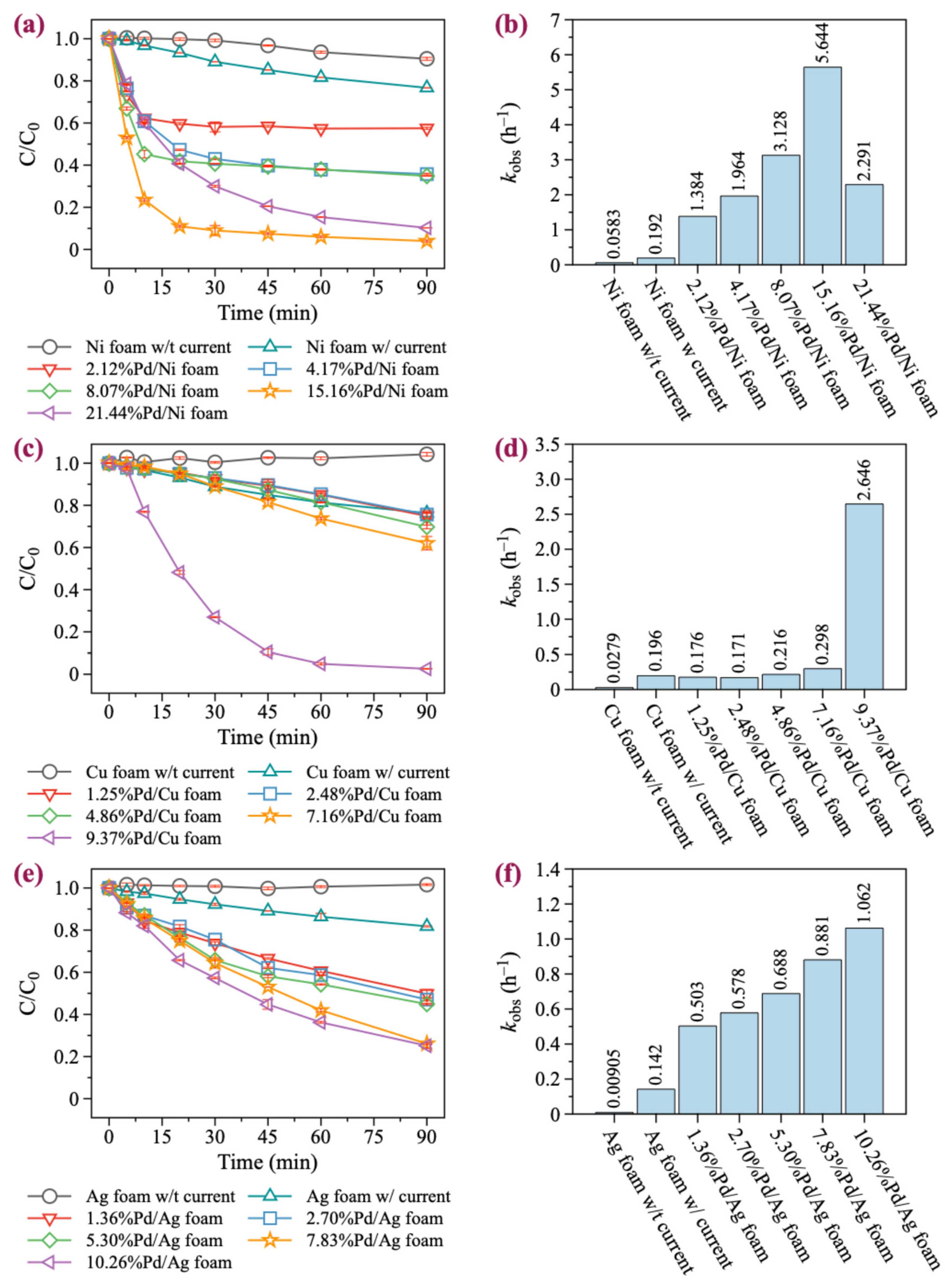


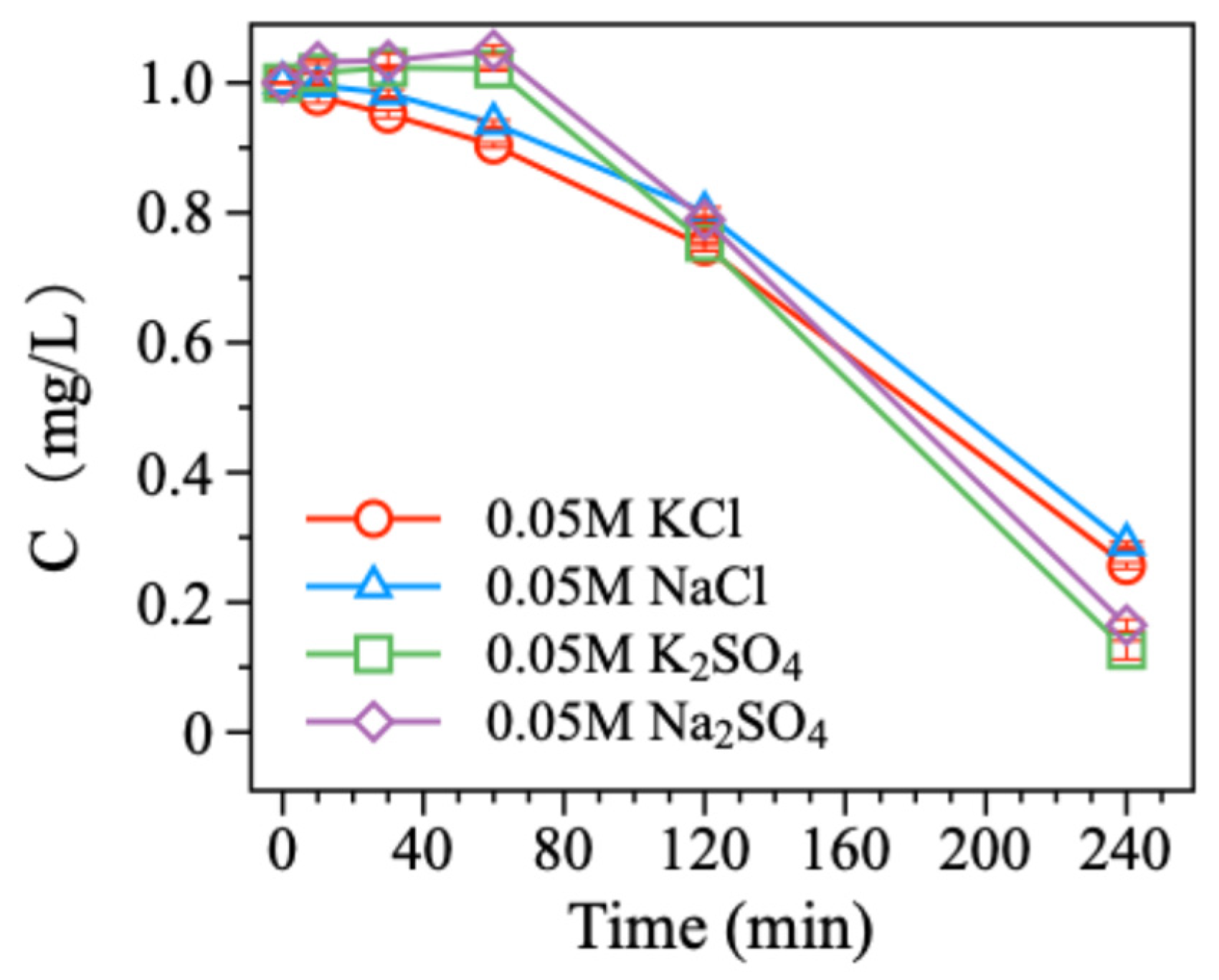
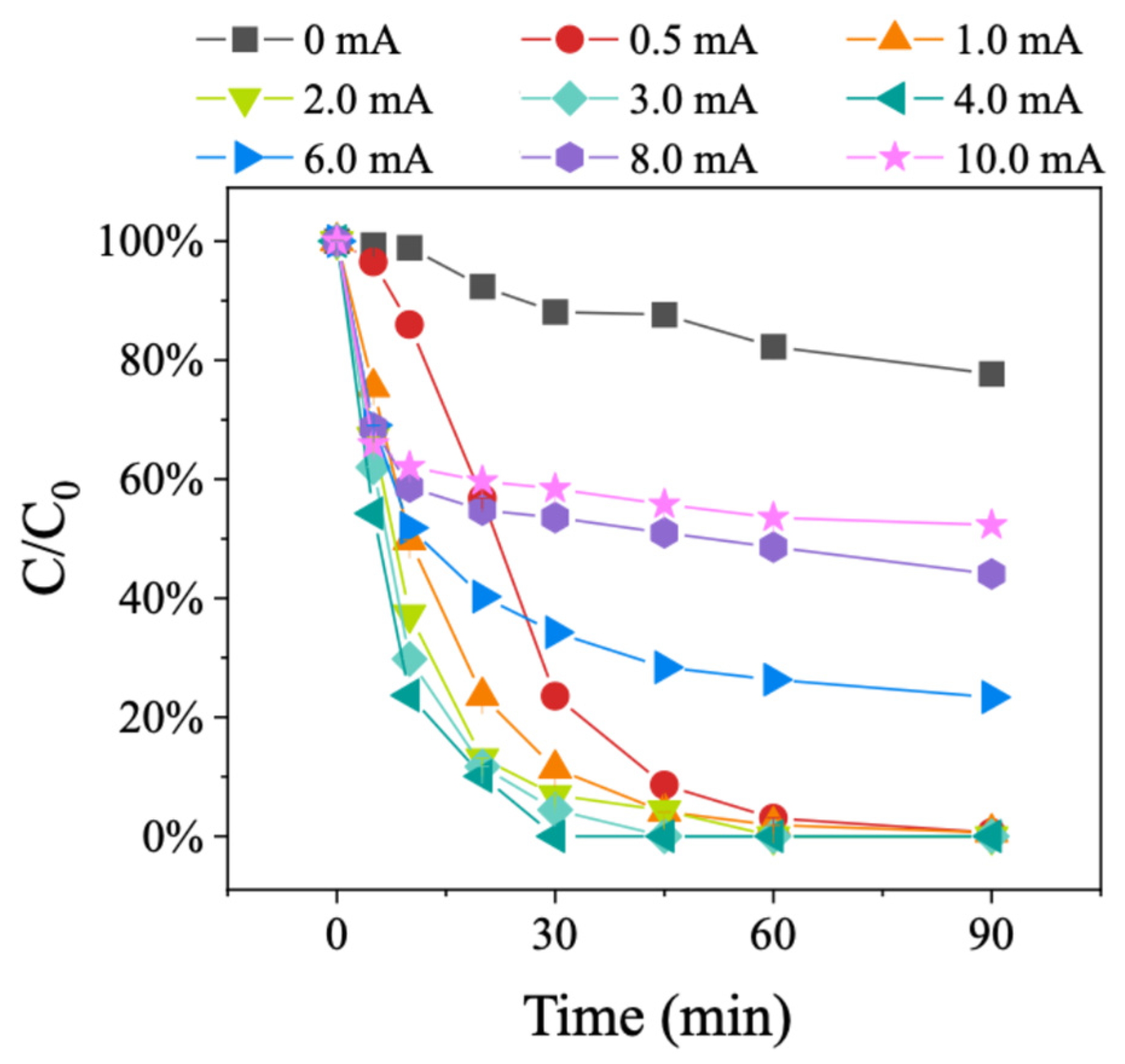

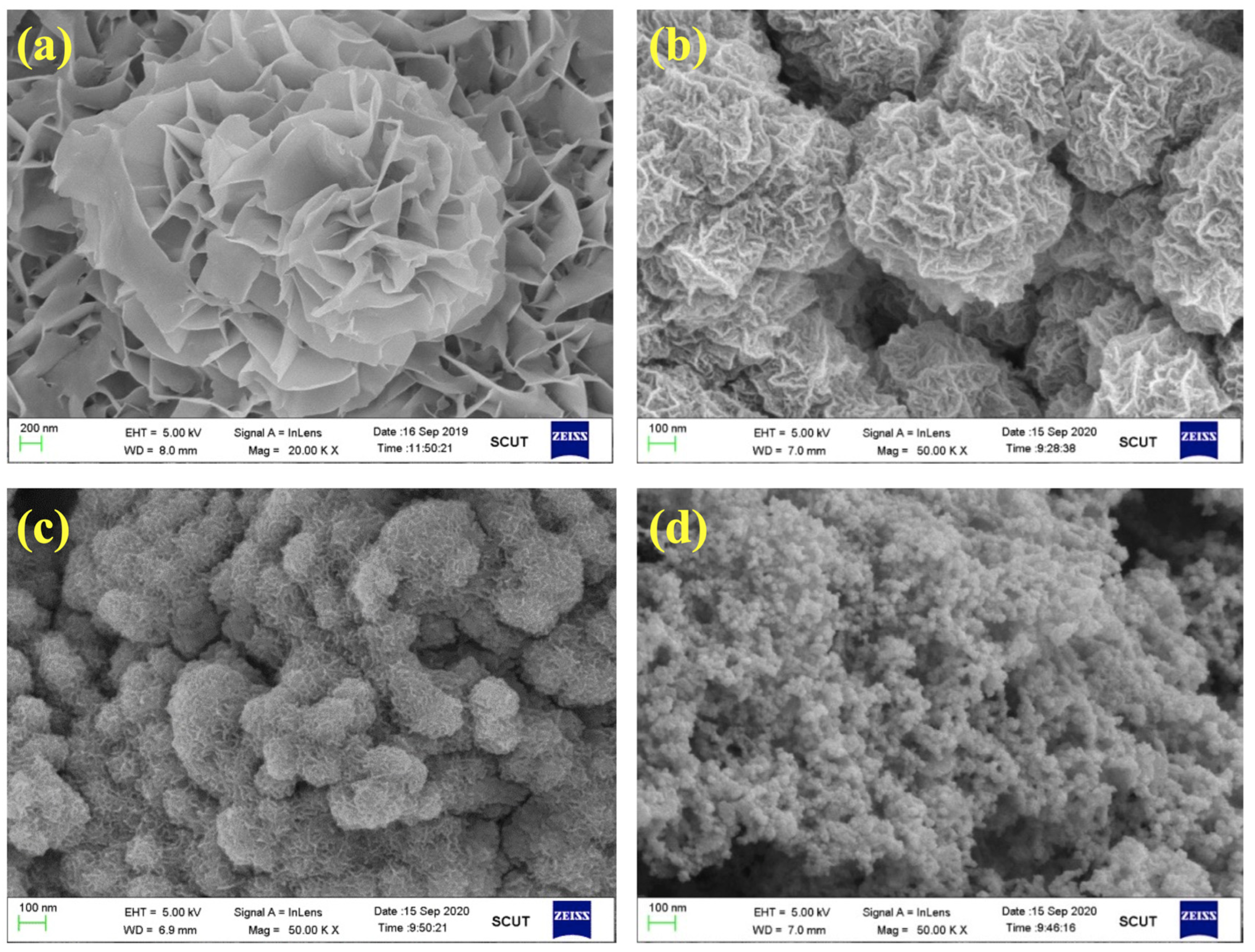
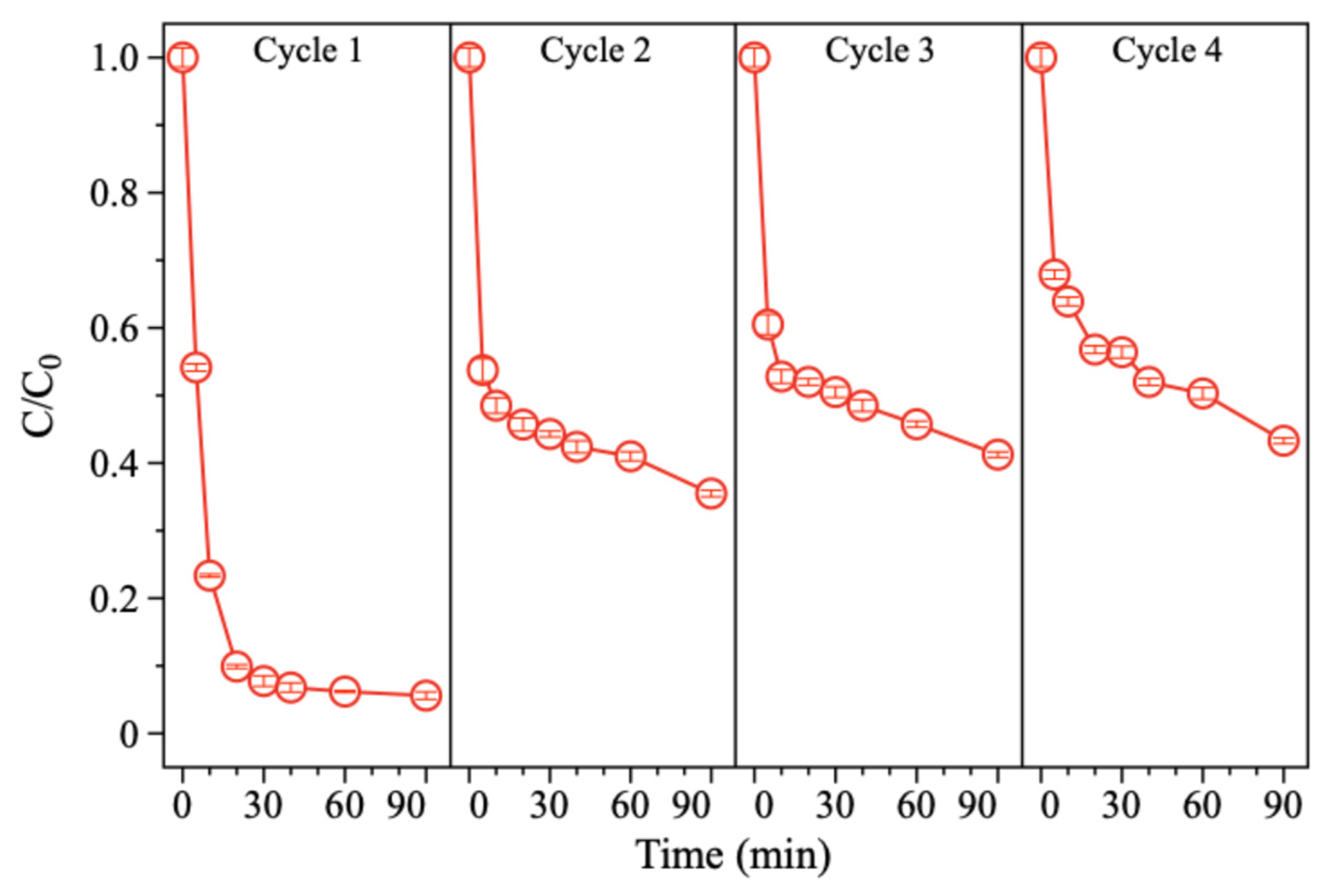
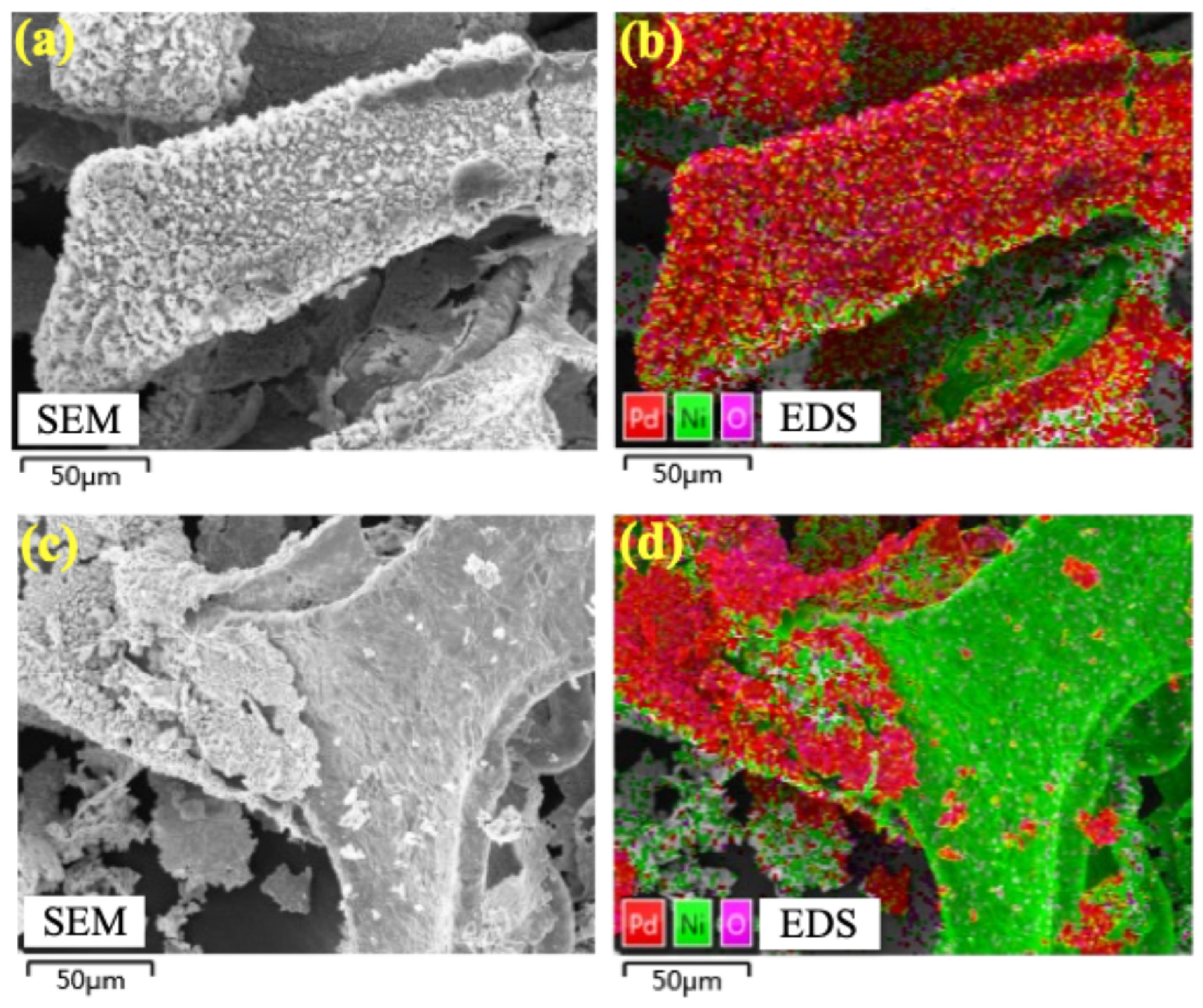
Disclaimer/Publisher’s Note: The statements, opinions and data contained in all publications are solely those of the individual author(s) and contributor(s) and not of MDPI and/or the editor(s). MDPI and/or the editor(s) disclaim responsibility for any injury to people or property resulting from any ideas, methods, instructions or products referred to in the content. |
© 2025 by the authors. Licensee MDPI, Basel, Switzerland. This article is an open access article distributed under the terms and conditions of the Creative Commons Attribution (CC BY) license (https://creativecommons.org/licenses/by/4.0/).
Share and Cite
Liang, C.; Liu, H.; Liang, J.; Du, X.; Tao, X.; Lu, G. Electrochemical Reduction Performance and Mechanism of 2,2′,4,4′-Tetrabromodiphenyl Ether (BDE-47) with Pd/Metal Foam Electrodes. Processes 2025, 13, 853. https://doi.org/10.3390/pr13030853
Liang C, Liu H, Liang J, Du X, Tao X, Lu G. Electrochemical Reduction Performance and Mechanism of 2,2′,4,4′-Tetrabromodiphenyl Ether (BDE-47) with Pd/Metal Foam Electrodes. Processes. 2025; 13(3):853. https://doi.org/10.3390/pr13030853
Chicago/Turabian StyleLiang, Chenghao, He Liu, Jiahao Liang, Xiaodong Du, Xueqin Tao, and Guining Lu. 2025. "Electrochemical Reduction Performance and Mechanism of 2,2′,4,4′-Tetrabromodiphenyl Ether (BDE-47) with Pd/Metal Foam Electrodes" Processes 13, no. 3: 853. https://doi.org/10.3390/pr13030853
APA StyleLiang, C., Liu, H., Liang, J., Du, X., Tao, X., & Lu, G. (2025). Electrochemical Reduction Performance and Mechanism of 2,2′,4,4′-Tetrabromodiphenyl Ether (BDE-47) with Pd/Metal Foam Electrodes. Processes, 13(3), 853. https://doi.org/10.3390/pr13030853







